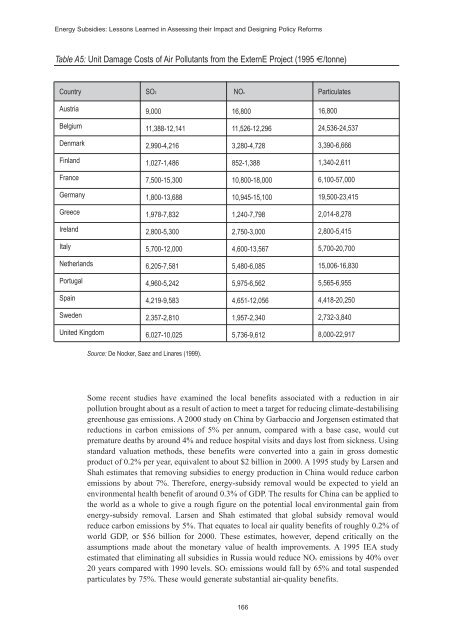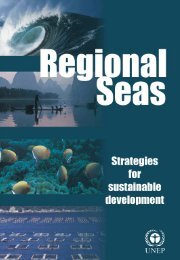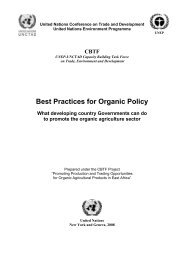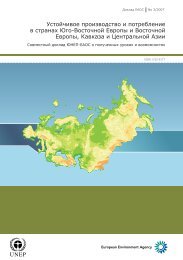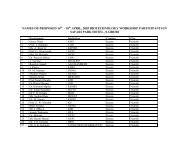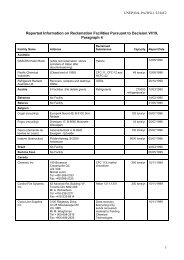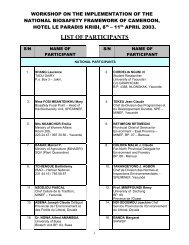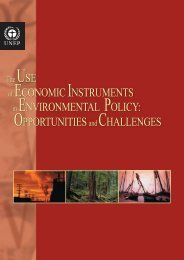<strong>Energy</strong> <strong>Subsidies</strong>: <strong>Lessons</strong> <strong>Learned</strong> <strong>in</strong> Assess<strong>in</strong>g <strong>their</strong> <strong>Impact</strong> and Design<strong>in</strong>g Policy Reforms Table A5: Unit Damage Costs of Air Pollutants from the ExternE Project (1995 €/tonne) Country SO2 NOx Particulates Austria 9,000 16,800 16,800 Belgium 11,388-12,141 11,526-12,296 24,536-24,537 Denmark 2,990-4,216 3,280-4,728 3,390-6,666 F<strong>in</strong>land 1,027-1,486 852-1,388 1,340-2,611 France 7,500-15,300 10,800-18,000 6,100-57,000 Germany 1,800-13,688 10,945-15,100 19,500-23,415 Greece 1,978-7,832 1,240-7,798 2,014-8,278 Ireland 2,800-5,300 2,750-3,000 2,800-5,415 Italy 5,700-12,000 4,600-13,567 5,700-20,700 Netherlands 6,205-7,581 5,480-6,085 15,006-16,830 Portugal 4,960-5,242 5,975-6,562 5,565-6,955 Spa<strong>in</strong> 4,219-9,583 4,651-12,056 4,418-20,250 Sweden 2,357-2,810 1,957-2,340 2,732-3,840 United K<strong>in</strong>gdom 6,027-10,025 5,736-9,612 8,000-22,917 Source: De Nocker, Saez and L<strong>in</strong>ares (1999). Some recent studies have exam<strong>in</strong>ed the local benefits associated with a reduction <strong>in</strong> air pollution brought about as a result of action to meet a target for reduc<strong>in</strong>g climate-destabilis<strong>in</strong>g greenhouse gas emissions. A 2000 study on Ch<strong>in</strong>a by Garbaccio and Jorgensen estimated that reductions <strong>in</strong> carbon emissions of 5% per annum, compared with a base case, would cut premature deaths by around 4% and reduce hospital visits and days lost from sickness. Us<strong>in</strong>g standard valuation methods, these benefits were converted <strong>in</strong>to a ga<strong>in</strong> <strong>in</strong> gross domestic product of 0.2% per year, equivalent to about $2 billion <strong>in</strong> 2000. A 1995 study by Larsen and Shah estimates that remov<strong>in</strong>g subsidies to energy production <strong>in</strong> Ch<strong>in</strong>a would reduce carbon emissions by about 7%. Therefore, energy-subsidy removal would be expected to yield an environmental health benefit of around 0.3% of GDP. The results for Ch<strong>in</strong>a can be applied to the world as a whole to give a rough figure on the potential local environmental ga<strong>in</strong> from energy-subsidy removal. Larsen and Shah estimated that global subsidy removal would reduce carbon emissions by 5%. That equates to local air quality benefits of roughly 0.2% of world GDP, or $56 billion for 2000. These estimates, however, depend critically on the assumptions made about the monetary value of health improvements. A 1995 IEA study estimated that elim<strong>in</strong>at<strong>in</strong>g all subsidies <strong>in</strong> Russia would reduce NOx emissions by 40% over 20 years compared with 1990 levels. SO2 emissions would fall by 65% and total suspended particulates by 75%. These would generate substantial air-quality benefits. 166
Annex: Methodological Approaches to Analys<strong>in</strong>g <strong>Energy</strong> Subsidy Reform A2.2 Global Climate Change Modell<strong>in</strong>g For global pollutants such as greenhouse gases from energy combustion processes, the overall impact of energy-subsidy policies on emissions can be assessed us<strong>in</strong>g global climate <strong>in</strong>tegrated assessment modell<strong>in</strong>g. This approach may draw on the results of economic modell<strong>in</strong>g. 118 Two major studies estimated the effect of fossil-fuel subsidies on global carbon levels. In both cases, the effects are expressed <strong>in</strong> terms of physical units. The 1992 study by Larsen and Shah, described <strong>in</strong> Table A3, estimated the size of fuel subsidies <strong>in</strong> every country by compar<strong>in</strong>g the domestic price of each type of fuel with its world price. The impact of the removal of subsidies on greenhouse gases was estimated us<strong>in</strong>g the relationship between energy prices and energy consumption and carbon-emission factors for each fuel. The study concludes that subsidy removal would reduce emissions by around 9% of global emissions. Because unsubsidised fuel prices on <strong>in</strong>ternational markets would fall as consumption <strong>in</strong> countries with subsidies falls, consumption would rise <strong>in</strong> other countries. The net reductions <strong>in</strong> global emissions would therefore be lower, at around 5%. The bulk of the reductions would come from countries that consume large quantities of subsidised coal, notably the former Soviet Union, Ch<strong>in</strong>a, Poland, South Africa, the former Czechoslovakia and India. A 1998 study by the OECD shows that the methodology employed and assumptions made crucially affect the results of analyses of the potential for reduc<strong>in</strong>g carbon emissions. The study reviews two studies, one by Anderson and McKibb<strong>in</strong> <strong>in</strong> 1997 and the 1994 DRI study. Anderson and McKibb<strong>in</strong> conclude that subsidy removal <strong>in</strong> the countries considered would reduce coal production, but that coal imports would rise. This would drive up the world price of coal, result<strong>in</strong>g <strong>in</strong> lower coal use <strong>in</strong> all countries. The result<strong>in</strong>g falls <strong>in</strong> carbon emissions would be substantial, at around 13% from the basel<strong>in</strong>e. The DRI study also predicted <strong>in</strong>creased coal imports <strong>in</strong> the countries that remove <strong>their</strong> subsidies, but no significant <strong>in</strong>crease <strong>in</strong> world prices. As a result, global carbon emissions would be hardly affected, fall<strong>in</strong>g by a mere 0.3%. The large differences <strong>in</strong> the results of these two studies are expla<strong>in</strong>ed by different assumptions about the price elasticities of supply 119 and the amount of subsidy removed 120 , and by different methodologies. 121 Us<strong>in</strong>g a slightly different approach, Steenblik and Coroyannakis (1995) showed that, even assum<strong>in</strong>g a one-for-one substitution of imported for domestically produced coal, elim<strong>in</strong>ation of subsidies to coal production <strong>in</strong> Europe could result <strong>in</strong> fewer emissions <strong>in</strong> greenhouse gases. For example, methane emissions from Europe’s deep, underground coal m<strong>in</strong>es are much greater than from the m<strong>in</strong>es from which imports would be sourced. And because imported coal tends to be lower <strong>in</strong> sulphur, emissions of CO2 would be saved through reduced scrubb<strong>in</strong>g requirements. However, the authors suggest that reform could lead to reduced consumption of coal <strong>in</strong> Europe — at least <strong>in</strong> the medium term — as many old, <strong>in</strong>efficient coal-fired power plants were be<strong>in</strong>g kept <strong>in</strong> operation simply to meet obligations to consume domestic coal. Once those obligations are removed (as happened <strong>in</strong> the UK), much of this capacity would be decommissioned and not all of it would be replaced by new coal-fired capacity. 118 A detailed description of this methodology can be found <strong>in</strong> Tol (1996). 119 DRI assumed a very flat or elastic supply curve compared with Anderson and McKibb<strong>in</strong>. 120 The level of subsidy removal <strong>in</strong> the DRI study was only half that of the level <strong>in</strong> the Anderson and McKibb<strong>in</strong> study. 121 DRI used partial equilibrium techniques, while Anderson and McKibb<strong>in</strong> employed a multi-country dynamic 167


